Millions of Americans identify as LGBTQ+. As the understanding of human sexuality and gender identity grows, knowledge can bring us together and foster deeper empathy. Language exists to clarify, but how familiar is the average American with LGBTQ+ terminology?
Like any group, the LGBTQ+ community has its own language to express who they are and the challenges they face. How does the understanding of LGBTQ+ language like pansexuality, heteronormativity, and gender-neutral pronouns differ by generation, sexual orientation, or gender identity? How far have we come as a nation in terms of understanding LGBTQ+ language, and how far do we still need to go?
Testing Knowledge of LGBTQ+ Terms
In November 2021, we quizzed 1,062 Americans across several demographics and all 50 states to uncover which LGBTQ+ terms Americans are most and least familiar with. We then analyzed the results by gender identity, age range, and sexual orientation to uncover disparities in the different demographics understandings of these terms. Read on to find out which LGBTQ+ terms are part of the average American‘s repertoire and which terms we need more education on.
Which LGBTQ+ Terms Are Americans Most & Least Familiar With?
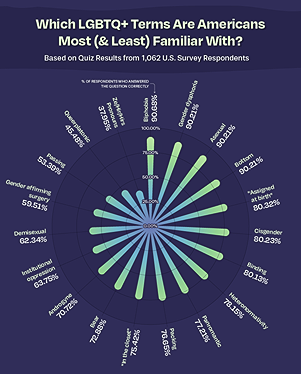
Based on quiz results, biphobia, gender dysphoria, bottom, and asexual were the LGBTQ+ terms Americans were most familiar with.
Biphobia is fear, hatred, or intolerance of bisexual men or women. It describes the aversion towards bisexuality and bisexuals as individuals or as a social group. It‘s possible to be biphobic without being homophobic. Bisexual people experience discrimination from straight and gay communities. People fear what they can‘t wrap their heads around. An example of biphobia would be assuming that bisexuals are indecisive about their sexuality or that everyone you meet is either heterosexual, lesbian, or gay. In the same way, bi men are often assumed to be gay when dating a man or assumed to be straight when dating a woman.
The terms Americans had the least familiarity with were ze/hir/hirs pronouns, queerplatonic, passing, and gender-affirming surgery.
Ze/hir/hirs are a neutral set of pronouns from the trans community. It‘s up to each person to decide which pronoun best fits them and their identity, so it‘s always best to ask someone about pronoun preferences. To differentiate from her, hir is pronounced with a long e, which sounds like he-er.
LGBTQ+ Terms With the Biggest Generational Disparities
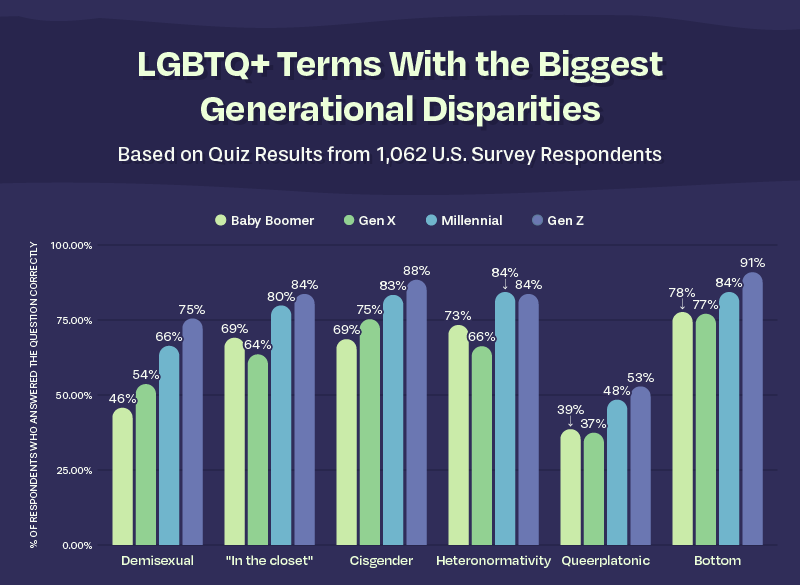
How does the understanding of LGBTQ+ language differ by generation? According to quiz results, millennials and Gen Z are more knowledgeable about LGBTQ+ vocabulary than older generations, which makes sense given younger generations are digital natives with regular exposure to LGBTQ+ language on social media platforms like TikTok, Instagram, and YouTube. A new mode of LGBTQ+ education and activism is taking shape and it starts on our newsfeeds.
Certain terms like queerplatonic tripped everyone up, regardless of generation. Overall, only 45.5% of respondents answered the quiz question with this term correctly. A queerplatonic relationship is a relationship that exceeds what is usually considered platonic. The aromantic community created this LGBTQ+ term to describe a relationship that is neither romantic nor platonic but still feels stronger than either. It‘s about forming a closer and more intimate bond without romantic qualities.
Other terms with the biggest generational disparities were demisexual, in the closet and cisgender. 75% of Gen Z quiz-takers answered the question about demisexuality correctly, compared to only 46% of baby boomers.
LGBTQ+ Terms With the Biggest Disparities by Sexual Orientation
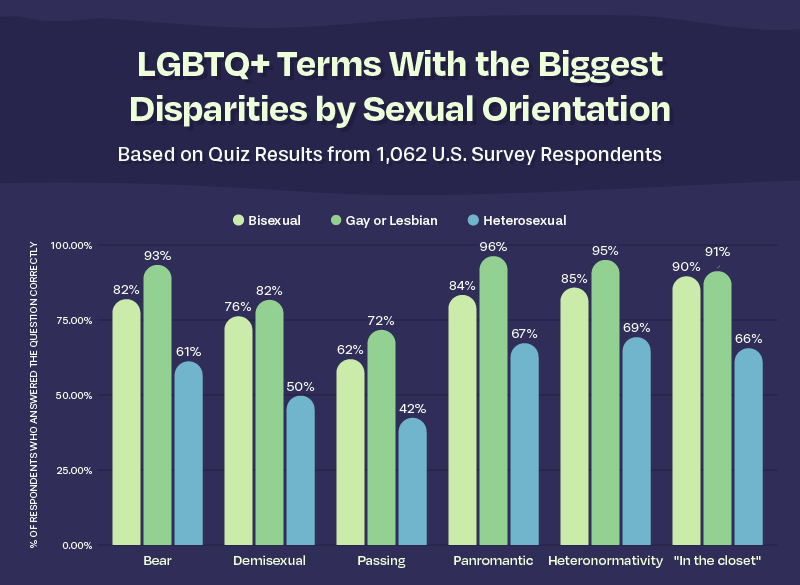
Based on our quiz results, straight Americans aren‘t nearly as familiar with these LGBTQ+ terms compared to those who identify as bisexual, gay, or lesbian. Passing was the lowest scored term for every sexual orientation. Passing can refer to a few things within the LGBTQ+ community. Generally, it‘s one’s ability to be regarded as a member of the sex or gender with their identity, or with which they physically present.
Another term with the biggest sexual orientation disparity was panromantic. 96% of people who identified as gay or lesbian answered the question with panromantic correctly, compared to only 67% of heterosexuals. Panromantic is a romantic attraction for people regardless of their gender. Someone who identifies as panromantic can be romantically attracted to people of every gender identity. People of any gender identity can identify as panromantic.
How Informed Do Americans Feel About LGBTQ+ Language?
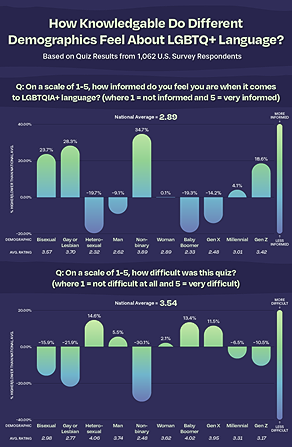
This is the part of the class where the teacher collects the quizzes and asks, “How was it?” On a scale of 1 to 5, how informed did you feel about the LGBTQ+ language? How difficult was the quiz?
Overall, Americans average 2.89 when asked how informed they feel about LGBTQ+ language on a 1-5 scale (where 1 = not informed and 5 = very informed). On the whole, this number is relatively low (below the median of 3); therefore, collectively we still have some work to do when it comes to educating ourselves on LGBTQ+ language.
Perhaps it shouldn‘t come as a surprise that people who identify in the LGBTQ+ community felt more informed about the language. Straight individuals and baby boomers didn‘t feel the most confident about their answers. Their average scores of 2.33 and 2.32 were almost tied, giving them the lowest ranking.
As for quiz difficulty, Americans average 3.54 when asked how difficult they found this quiz on a 1-5 scale (where 1 = not difficult and 5 = very difficult). A number above the median indicates that the quiz was relatively difficult for Americans across the board.
While these findings shed light on how far we‘ve come in our openness and discussion of the LGBTQ+ community, I think it is safe to say there is still work to be done, commented sexual health and wellness expert Dr. Evan Goldstein. While we have seen successes in recent years, there continues to be a lack of education across the nation in this sector of the population. My goal, as a member of this community and expert in the field of gay men‘s sexual health, is to continue to shed light on the need for education and access to the same level of social, economic and medical treatment and services of the straight community. At Bespoke Surgical and Future Method, we pride ourselves on contributing to the effort to de-stigmatize discussions around the LGBTQ+ community and continue to be a resource for education and empowerment for those looking to be an ally.
LGBTQ+ Glossary of Terms
When it comes to LGBTQ+ terminology, disparities in understanding certainly exist between different demographic groups, some larger than others. But the first step to allyship and understanding is to educate yourself so you can create a more inclusive space. Bespoke Surgical is a practice built on understanding and inclusivity, so we’ve crafted a full glossary of LGBTQ+ terms to help us all use language that is both respectful and supportive of this community.
Ready to test your knowledge?
About the Author
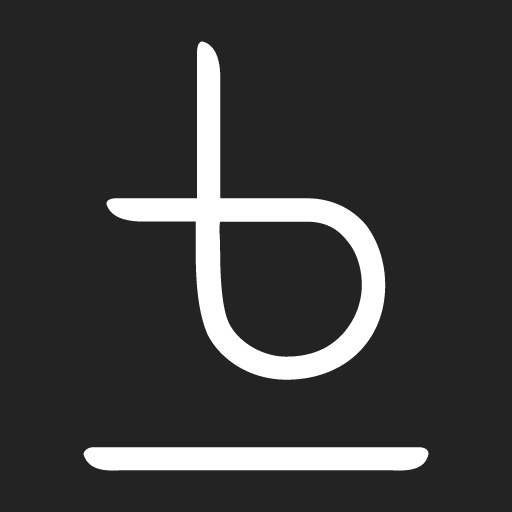
Consistent, proactive, and thoughtful healthcare is not only a priority, it is a demand by men who live well. Bespoke Surgical is built on this understanding. Today's modern, urban male has become adept at making the most of life, believing in living fully and completely in all aspects of work, fitness, relationships, and family. This makes excellent health more important than ever.
Join Our Newsletter
Subscribe to receive exclusive content, new product information, and the latest news.
Featured products
Read More
General
How Many Dating App Matches Does It Take To Find A Hookup?
When it comes to finding a hookup on dating apps, it’s truly a numbers game....
General
The Landscaping “Down There” Survey
What does the modern American’s hair removal routine really look like and what’s the motivation...
General
The Nudity Confidence Survey
The recent Vanderpump Rules drama has captivated audiences in the reality TV universe and shined...
